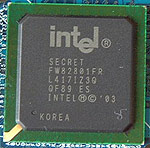The Intel ICH6 SouthBridge adds a little more
into the mix where the quite popular ICH5 left off. First off, ICH6 natively
supports four Serial ATA ports, an increase from its predecessor. However, there
are also some rather important features no longer there, like IDE.
The ICH6 supports just one IDE channel now, primarily for use with CD-ROMs. The
emphasis is really on SATA hard drives, so next time you are looking
to upgrade your storage don't bother with anything other than Serial
ATA.
For your expansion needs, Intel's ICH6
introduces support for PCI Express, which one of the most radical changes to
desktop computer infrastructure in recent times. The ICH6 handles up to four PCI
Express x1 slots, or six regular PCI slots. The videocard PCI Express x16 slot
is the responsibility of the 915P northbridge.
 With IDE quickly going the way of
low gas prices, Serial ATA devices are where it's at. Being that IDE
RAID was a very popular selling point of many motherboards, it would be a
tragedy if consumers were shuffled back to the days before RAID with SATA. This
isn't the case, thankfully.
With IDE quickly going the way of
low gas prices, Serial ATA devices are where it's at. Being that IDE
RAID was a very popular selling point of many motherboards, it would be a
tragedy if consumers were shuffled back to the days before RAID with SATA. This
isn't the case, thankfully.
The Intel ICH6R variant supports RAID, which
Intel calls its "Storage Matrix Technology." The RAID feature is only found in ICH6R southbridges, and it supports
RAID modes 0, 1 and 0+1.
Intel High Definition
Audio
The ICH6R southbridge contains its own audio
subsystem, which Intel hopes will ensure better audio quality for motherboards
based on its new chipsets. Intel's 'High
Definition Audio' is a step up from the stock AC'97 audio we all love to hate.
The better breading of this audio controller
makes the 7.1-channel audio system packed into the Gigabyte GA-8GPNXP Duo worth
taking note of.
Intel 'High Definition Audio' boasts a long list of
features, but one of the cool things it can do is enable up to two
separate streams of audio at once (say, MP3's through the old home stereo, and
gaming on the PC through a set of headphones), with each stream able of
delivering eight channels at 192 kHz/32-bit quality.
Additionally, along with the GA-8GPNXP Duo's full
compliment of jack-sensing audio ports are a set of SPDIF in / out connections
at the rear I/O panel. With these two SPDIF RCA ports, the GA-8GPNXP Duo could
be connected directly to home theatre system, or used for multimedia editing of
audio from another source. Now, let's see what the GA-8GPNXP Duo can do for
us in the way of overclocking!
Overclocking
Tests
It's a shame Gigabyte does not focus more on
the enthusiast market considering how well the do everything else. We started at 200 MHz FSB and everything was uneventful until 216 MHz
FSB - at that point anything higher would cause the system
to lock up. We tried increasing some voltages for the CPU, DDR/DDR2, and PCI Express videocard, but
nothing alleviated the issue. Swapping out the DDR-2 RAM for a couple of sticks of standard DDR
didn't help either.
I'm not sure exactly what was holding us back
but further testing on this front is definitely called for. Next up, the
BIOS and benchmarks!
